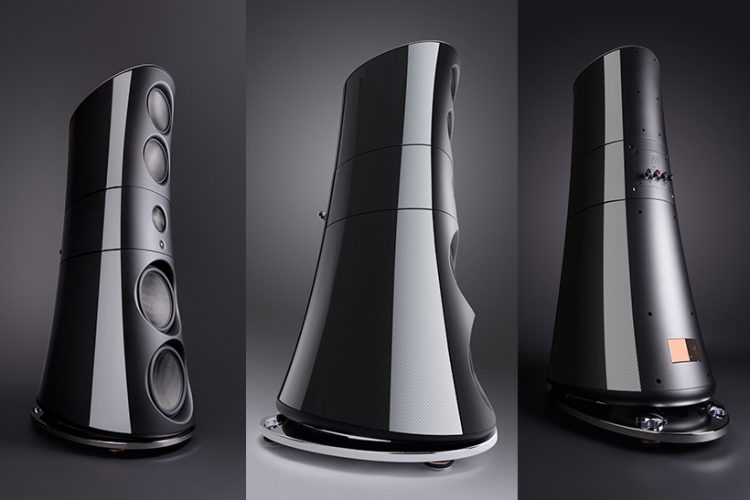The Magico M9 four-way, six-driver floor standing loudspeaker features “the world’s first” loudspeaker enclosure to combine inner and outer skins of carbon fibre with an aluminium honeycomb core. Included with the M9 is an outboard active crossover, the MXO. In addition, the M9 benefits from our latest generation of Nano-Tec speaker cones, featuring aluminium honeycomb cores.
The enclosure also incorporates constrained layer damping using aerospace composites, plus familiar features of Magico construction including a baffle board of 6061 T6 aircraft aluminium and front-to-back tensioning rods. Through many rounds of Finite Element Analysis modelling, we fine-tuned the enclosure design to suppress resonances and any possibility of stored energy. We also calibrated the organic shape of the enclosure and machined the front baffle to reduce diffraction effects to “near zero”.
Beryllium-diamond dome tweeter
Magico has long recognized that the bending and flexing of non-pistonic motion in a soft dome tweeter leads to “large-scale distortion”. That’s why Magico chose the high strength and light weight of beryllium. This is enhanced with the incredible stiffness of diamond, carefully applied by chemical vapor deposition. This enabled them to build the world’s first 28 mm beryllium dome.
Eighth gen Nano-Tec cones
Every cone in the M9 incorporates our eighth generation Nano-Tec design featuring an aluminium honeycomb core sandwiched between graphene/carbon fibre skins. In previous Nano-Tec cones, the skins provided all the stiffness and the core provided damping. The aluminium honeycomb core material is so stiff that we need to apply 26,500 pounds (12,000 kg) of pressure to shape the 15-inch cones.
As a cone driver plays intense musical peaks, voice coil temperatures can climb over 100° F (40° C) in a single second. Heating can double the voice coil’s DC resistance, alter the frequency response curve and compress the music as much as 3 dB – a substantial nonlinearity. The M9 cone voice coils are “huge” – 3, 4 and 5 inches in diameter – for much faster dissipation of heat and greater control over the cone. Vents in the voice coil formers provide another level of heat dissipation. We chose formers of pure titanium for its combination of stiffness and resistance to eddy currents.
Underhung voice coil and oversized magnets
Magico Nano-Tec drivers exercise “absolute control” over voice coil movement by providing underhung voice coils in a magnetic circuit of tremendous power. We use uncommonly large neodymium ring magnets. As an extra measure against asymmetry, these drivers deploy a matching magnet on top. The result is flux density, up to 1.7 Tesla (17,000 Gauss), maintained across uncommonly long air gaps, up to 36 mm. This enables distortion-free output up to 120 dB SPL at 1 metre.
6-inch midrange driver (x1). The new midrange features a 4-inch voice coil to help maintain linear output all the way to 120 dB SPL at 1 metre. This results in “unmeasurably low distortion” throughout the driver’s operating range.
11-inch mid bass drivers (x2). This entirely new driver incorporates an N48H grade neodymium ring magnet of unusual size: 120 mm diameter x 8 mm height, plus a second matching magnet on top for complete control of voice coil movement.
15-inch bass drivers (x2). The new bass driver has an uncommonly long 36 mm air gap facilitates tremendous linear excursion, ±15 mm, at high sensitivity.
Magico Analogue Crossover (MXO)
The 120 Hz crossover frequency between the bass and mid-bass drivers poses a special challenge. At such a low frequency, a passive crossover would require huge inductors and capacitors. Even if the very best parts were auditioned and selected with care, such large circuit elements would incur unavoidable, substantial losses. To overcome this issue, we created an analogue, active 2-way crossover, the Magico Analogue Crossover or MXO. This provides steep filter slopes without any sacrifice in signal quality.
The crossover’s meticulous design features Linkwitz-Riley filters to deliver 24 dB per octave slopes at the crossover frequency of 120 Hz. The analogue crossover is fully balanced with completely discrete circuitry from input to output. Open architecture accommodates additional filter topologies. Precision step attenuators provide 0.5 dB/step control of each output, using a proprietary technique to ensure purity in the signal path. The external power supply chassis regenerates AC and applies active regulation to every part of the circuitry.
The M9 tweeter, midrange and mid-bass drivers are controlled by a three-way passive crossover with acoustical target 24 dB-per-octave Linkwitz-Riley filters. Magico’s elliptical symmetry crossover design “preserves maximum frequency bandwidth with minimal IM distortion”. A pair of M9 loudspeakers requires two stereo or four monaural amplifiers.
The Magico M9 begins shipping in Q4 2020. The UK RRP is officially ‘price on application’ but is expected to be in the region of £840,000 inc. VAT per pair. Each speaker stands over two metres tall and weighs 454kg.


